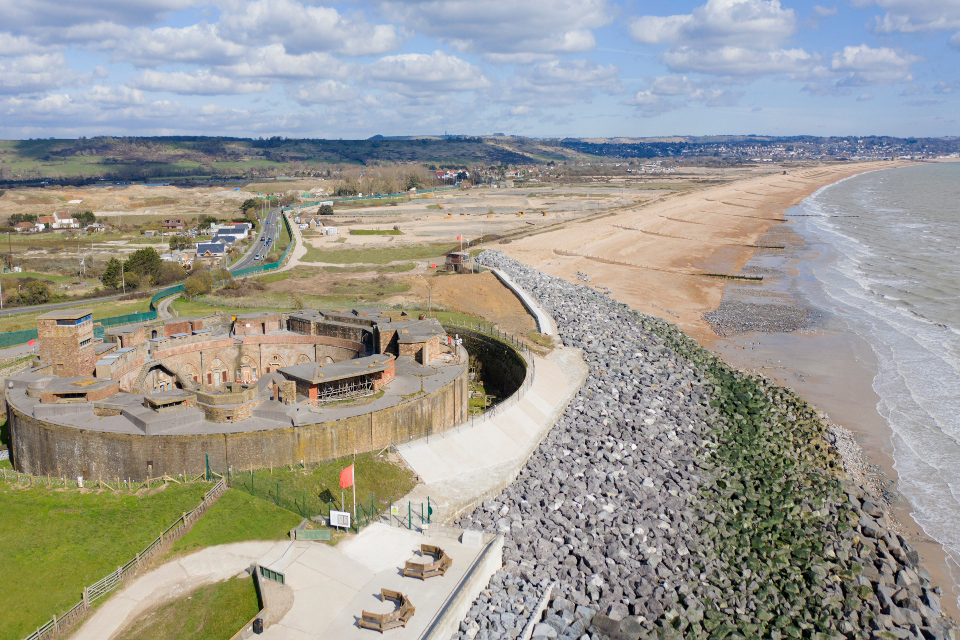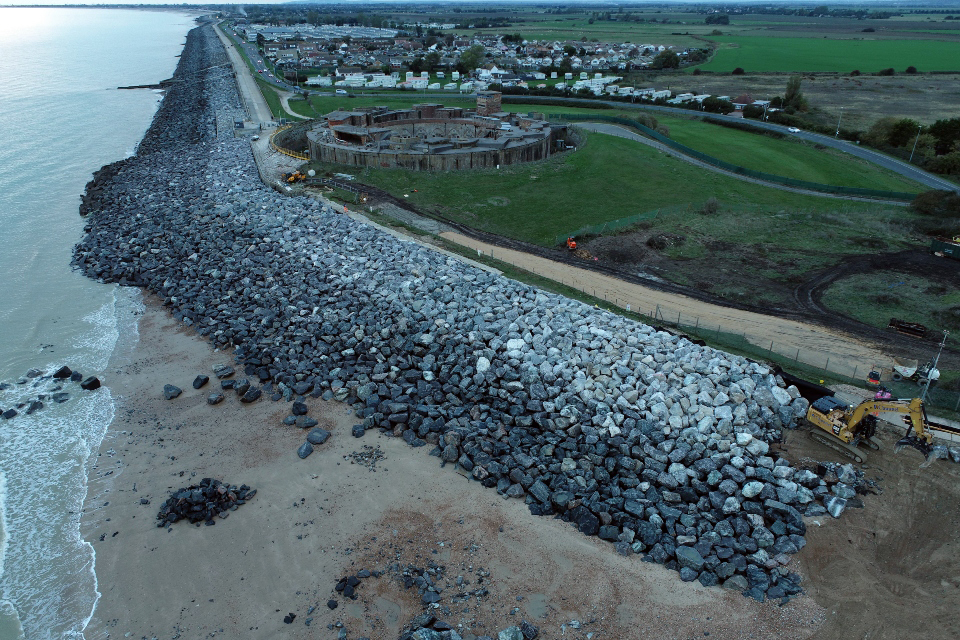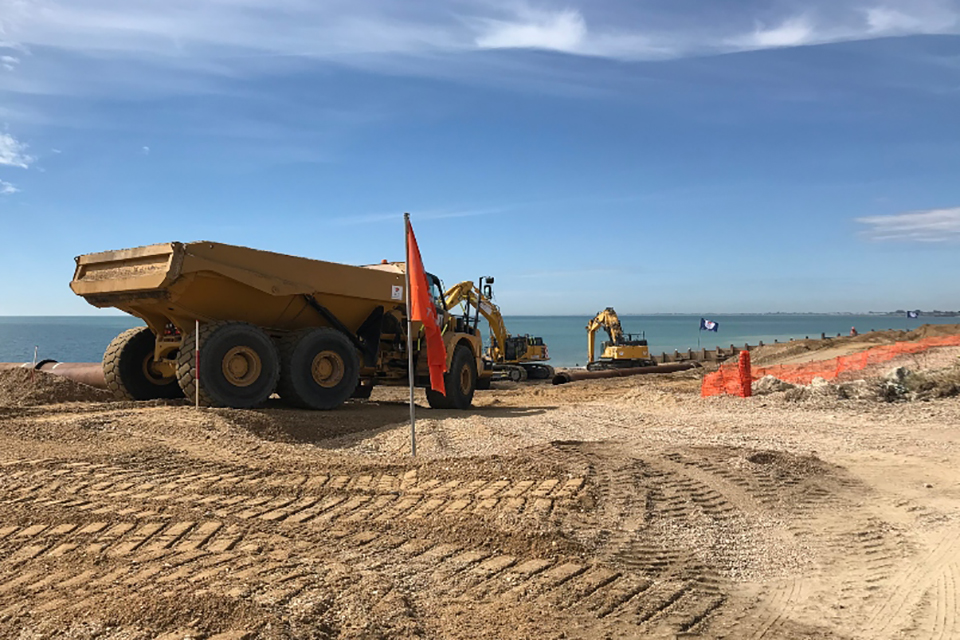Hythe Ranges sea defences renovation
Updated 26 March 2021
Hythe Ranges sea defence scheme
The Hythe Ranges scheme is a major coastal flood defence between Hythe and Dymchurch on the south Kent coast.
Works to improve the defences were completed in winter 2020/21 and will reduce flood risk to 787 properties. The standard of flood protection has been improved to better protect against a flood event with a 0.5% chance of occurring in any given year.
The frontage is approximately 3.25 kilometres long between Dymchurch Redoubt in the West and Fisherman’s Beach in the east. Most of this is owned and operated by the Ministry of Defence (MoD) as a live firing range. A 150m stretch at the eastern end known as Fisherman’s Beach is owned by Folkestone and Hythe District Council.
Construction of the Hythe Ranges scheme began in spring 2020 and the works were delivered entirely within the Covid-19 pandemic. By working closely within government and Public Health England safe working guidelines, there were no incidents of Covid-19 on site.

The completed Hythe Ranges sea defence scheme, March 2021
The works cost £25million and were delivered in partnership with the MoD, which contributed 25% of partnership funding towards costs, including future maintenance. Construction at the site required close liaison with the MoD to minimise disruption at its training facility.
Watch the video on the Environment Agency YouTube channel to see how the scheme was delivered.
Hythe Range Sea Defence scheme
The works involved:
- refurbishing and raising 30 timber groynes
- constructing a 200 metre rock revetment around the historic Dymchurch Grand Redoubt
- recharging the shingle beach with over 300,000m3 of material.
The groynes were constructed from 100% Forest Stewardship Council (FSC) timber, including FSC certified recycled material. Around 5 to 10% of the timber from the old groynes was re-used in the new structures, with the remainder recycled or re-used by third parties. This included construction of benches from recycled timbers which have been installed on the public promenade.

Works to refurbish the existing groynes
Rock revetment
A 200 metre long rock revetment was constructed to help to shield the historic Dymchurch Grand Redoubt, a 200 year old military fort requiring Scheduled Monument Consent and Listed Building Consent. The revetment used 37,000 tonnes of imported Norwegian granite, which merges with the existing Dymchurch seafront.

The rock revetment will reduce risk of flooding from the sea to the Dymchurch Grand Redoubt and nearby properties
The rock revetment will reduce risk of flooding from the sea to the Dymchurch Grand Redoubt and nearby properties
Shingle was pumped to the beach via pipeline from a licensed dredging area south of Eastbourne. This was then spread on the beach using dumper trucks, excavators and bulldozers. Staff worked around the clock to remodel the beach, working around high tides.

The Vox Amalia imported over 300,000m3 of shingle to the Hythe Ranges frontage to form a vital part of the defence

Dumper trucks, excavators and bulldozers worked around the clock to remodel the beach once the shingle had been imported
Environmental enhancements
The project included environmental enhancements to encourage the development of intertidal habitat.
This included using a mechanical rock grinder attached to an excavator to create artificial rock pools that were then placed in the granite rock revetment. This method was a change to previous approaches using hand-held machinery. This not only improved output rates but delivered health and safety benefits by avoiding staff exposure to excessive vibration.
- Over 70 rock pools were created and installed.
- Within 48 hours sand eels had been identified in the pools.
- Other enhancements included the installation of ‘vertipools’ on new timber groynes to provide a sheltered habitat for marine species and installing rope on timbers to encourage seaweed colonisation.
Reducing the carbon footprint
The project achieved efficiencies of more than £2.5 million and saved more than 1,660 tonnes of carbon dioxide equivalent (CO2e) including:
- 490t CO2e saved by realigning a sheet pile wall to reduce total steel by 75%
- 390t CO2e saved by optimising the construction of the rock revetment toe and use of a geotextile to reduce the rock volume by 30%
- 570t CO2e from reducing the number of timber groynes from 45 to 30, saving approximately 30% of the timber volume
- 215t CO2e saved on concrete including the pioneering use of low carbon concrete. Folkestone to Cliff End Strategy (FoCES)
The Hythe Ranges sea defence scheme is part of the Folkestone to Cliff End Strategy (FoCES) approved by Defra in 2010. The strategy sets out our plans to manage flood and erosion risks along the coastline of Romney Marsh over the next 100 years, taking the predicted impacts of climate change into account.

